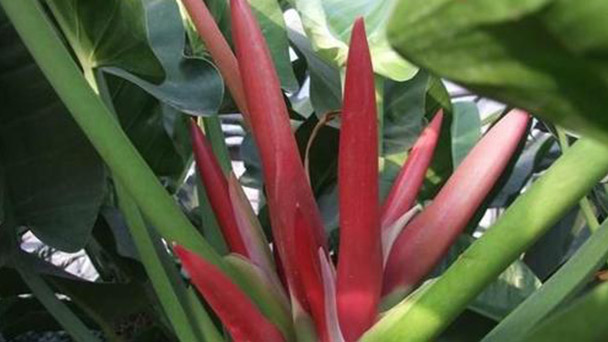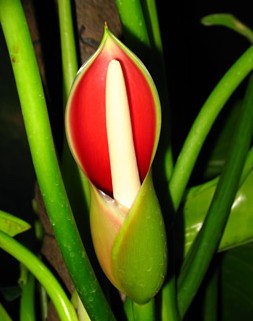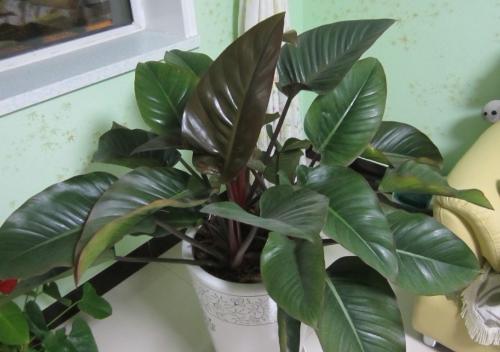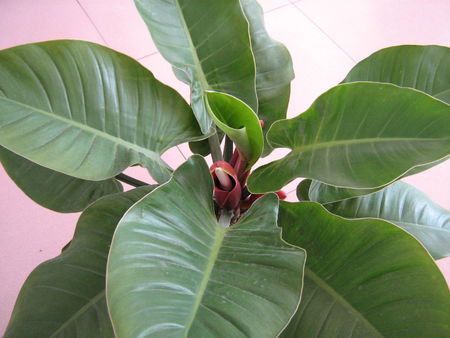How to Grow Philodendron Erubescens - Plant Care & Propagation
Written by Maggie
Jan 07 2023

As Philodendron Erubescens prefers medium indirect light, you can place it in a location with bright indirect light and water it whenever the soil becomes dry.
Before the maintenance of Philodendron Erubescens, we must choose a slightly acidic soil with loose texture, fertile soil, good air permeability, and good drainage in the later period; and control its growth temperature between 22~26℃; ensure that every day More than six hours of light duration; watering once a week, fertilizing twice.
Philodendron Erubescens Picture

Philodendron Erubescens Overview
The plant can grow up to 60 feet tall in its natural habitat, and if its connection to the ground is broken, it will occasionally switch over to fully epiphytic growth. But as a houseplant, it's likely that your plant will stay about 3 feet long, and it's simple to take care of.
| Common Name | Blushing philodendron, red-leaf philodendron, imperial red philodendron |
| Botanical Name | Philodendron erubescens |
| Family | Araceae |
| Plant Type | Perennial |
| Mature Size | 2-60 ft. long, 16 in. wide |
| Sun Exposure | Partial |
| Soil Type | Well-drained, loamy |
| Soil pH | Neutral, acidic |
| Bloom Time | Spring, summer |
| Flower Color | Red |
| Hardiness Zones | 10-11 (USDA) |
| Native Area | Central America, South America |
| Toxicity | Toxic to people and pets |
How to Care for Philodendron Erubescens
Soil Selection
Philodendron erubescens C. Koch et Angustim has very high requirements on the soil. Before breeding, you need to choose a slightly acidic soil with loose soil, fertile soil, good air permeability, and good drainage in the later stage. Choose sandy soil, peat soil and humus layer soil according to 1. :1:1 ratio mixed preparation, you can also add a small amount of bone meal or cake fertilizer as base fertilizer, which will help plants better absorb nutrients.
Control Temperature
Philodendron erubescens C. Koch et Angustim is an ornamental plant imported from foreign countries, then what is the cultivation method of Philodendron erubescens C. Koch et Angustim? We must reasonably control its growth temperature during breeding. The most suitable temperature for its growth is 22~26 Between ℃, if the plant is lower than 15℃ for a long time, it will cause the leaf surface to turn yellow, and the root system will rot seriously.
Illumination
Philodendron erubescens C. Koch et Angustim is a light-loving plant. It is necessary to ensure more than six hours of light a day. It can be kept outdoors for maintenance. If it is not exposed to sunlight for a long time, the leaves of Philodendron erubescens C. Koch et Angustim will shorten and affect Beautiful; in the hot summer, we still have to do a good job of shading to avoid the plants from being exposed to the sun.

Watering
Philodendron erubescens C. Koch et Angustim likes to grow in a humid environment, but does not have the ability to resist drought. Just water it once a week; when watering it, it should be watered thoroughly to ensure that the root system absorbs sufficient water, and the plants should be given frequently Spray water mist to keep Philodendron erubescens C. Koch et Angustim in a humid state.
Fertilization
During the growth period of the Philodendron erubescens C. Koch et Angustim plant, fertilize twice a week. Generally, a thin fertilizer with a ratio of phosphorus, potassium, and nitrogen of 1:2:3 is selected, and a 0.2% trace element mixture can also be used in combination. Apply a 0.2% potassium dihydrogen phosphate solution once, and stop fertilizing after winter to avoid fertilizer damage and affect plant growth.
Pruning
Although philodendrons don't require frequent pruning, they can occasionally outgrow their surroundings or grow long and leggy. The best time of the year to prune P. erubescens is during the spring or fall, though you can remove yellow leaves or trim thin growth at any time of year.
Use sterile, razor-sharp scissors or pruning shears to make cuts on a philodendron. If you can't see where the stem connects to the plant's main vine, cut the stem off at the soil's surface. Otherwise, cut where the stem meets the vine.

Propagating Philodendron Erubescens
Like most vining philodendrons, P. erubescens can easily be propagated by cuttings and division. Make sure to take a piece of the stem that has several aerial roots when you cut it. Older plants develop aerial roots on their leaf nodes that serve as roots and grasp objects. The best time to divide philodendrons is in the spring when they are actively growing, but if they are outgrowing their pots, they can be divided at other times of the year. Here's how:
- Step 1: For the cutting, gather a fresh container, then fill it with the proper soil blend.
- Step 2: To take a cutting, find a stem that has numerous aerial roots. Find a stem that is growing on the side of the plant if you plan to divide the plant.
- Step 3: Trim off the stem of your choice using a fresh pair of gardening shears.
- Step 4: The stem should be planted in its new container and placed in an area with strong indirect light.
- Step 5: After watering the soil and letting it completely drain, take normal care of the plant.
How to Grow Philodendron Erubescens from Seed
Growing P. erubescens from seed is a relatively simple process. Get your philodendron seeds, a new pot with soil in it, and some plastic wrap. After planting the seeds in moist soil at a depth of about 1/3 inch, cover the pot with plastic wrap to keep moisture inside until the seeds germination. To make sure the soil doesn't dry out, check it frequently. Place the pot in a location with constant temperatures between 70 and 75 degrees Fahrenheit and bright, indirect light. The seeds ought to sprout in two weeks to two months. The plants can now be cared for as normal.
Potting and Repotting Philodendron Erubescens
Younger P. erubescens plants are rampant growers. Your plant will probably require repotting every spring at the start of the growing season. It's helpful to provide some structure for it to climb on after its first year, when it's ready to climb (or even on its first repotting after sprouting).
This plant isn't necessarily picky about what it likes to climb, but it can be difficult to train a plant to "take hold" of its climbing pole and begin its ascent. The main vine should be carefully tied to the support and trained upward to promote climbing. It's hoped that eventually it will decide on its own to grab onto the pole. Because of the climbing poles, repotting older plants is much more difficult. If this is a problem, just scrape off the top soil layers and replace them with new soil and fertilizer.
Overwintering
P. erubescens should be grown indoors in most climates to maintain consistent temperatures, but some hotter regions of the country can accommodate this species outdoors year-round. If you live in an area that doesn't drop below 55 degrees Fahrenheit in the winter, your P. erubescens can survive outside.
However, if the plant is left outside during the growing season, overwintering indoors is necessary when growing this plant in other regions. Transplant your plant gradually inside, into a space with similar temperatures, indirect light, and bright lighting. In the spring, you can move your plant back outside once the nighttime lows are above 55 degrees.
Common Pests & Plant Diseases
Pests such as aphids, mealybugs, scale, and white flies can harm philodendrons. If at all possible, locate any infestations of pests as soon as possible. Treat pests on your P. erubescens plant by mixing 2 1/2 tablespoons of Spray the entire plant with a solution of one gallon of water and one tablespoon of Dawn dish soap.
Your P. erubescens may also be susceptible to leaf spot diseases, which appear as either brown or yellow spots on the leaves. Fortunately, these fungi diseases can usually be avoided by watering your plant from the bottom up rather than directly on the leaves to keep them dry. Apply a fungicide to all of the stems and leaves of plants that have already experienced mild damage.
How to Get Philodendron Erubescens to Bloom
Philodendrons are not self-pollinating, so it's necessary to hand pollinate your indoor P. erubescens plant to encourage blooming. Deep red flowers from this species bloom for a few days at a time in the spring and summer. Prior to its blooming season, keep your philodendron in an area that experiences regular warm temperatures. When your plant's spathe is open at night, use pollen to coat the spadix in order to pollinate it. It is possible to trim (or deadhead) the flowers from the plant after they have bloomed.
Common Problems With Philodendron Erubescens
Generally speaking, philodendrons are among the easiest plants to grow, but there are still a few typical issues that can arise. This is frequently caused by the plants receiving too much sunlight or water (or not enough), and the majority of problems can be fixed using a few straightforward techniques.
Yellowed Leaves
The growing conditions of the plant can help identify one of several potential causes if the leaves on your philodendron are turning yellow. For instance, a philodendron that has received excessive water may experience yellowing of the leaves or root rot. On the other hand, the leaves may start to turn yellow from too much sun. Depending on your plant's needs, move it to a shadier location or reduce the amount of water it receives.
Brown Leaves
Browning of the leaves on a submerged philodendron is possible. In this situation, increase the frequency of watering your plant while making sure that its pot still has adequate drainage to prevent the onset of root rot.
Dark Leaf Spots Or Edges
Philodendron plants exposed to excessively bright light frequently develop leaf scorch. This manifests as dark leaf spots or dark leaf edges. Your plant should be moved to a more shaded location, and you should look for any indications of a fungus disease that might also cause dark spots.
Philodendron Erubescens Varieties
Philodendron Pink Princess
The Philodendron pink princess is beautiful when it grows as an indoor plant with its dark green leaves and variegation of pink. With their trailing vines, you can grow them in pots and hang them from a macrame plant hanger.
Red Emerald Philodendron
The Philodendron red emerald or Philodendron peperomia is another red variation evergreen plant. The stem is red, and the foliage is dark green.
Philodendron Erubescens'Imperial Red'
The perennial evergreen has glossy red new leaves that emerge and a climbing habit.
FAQs
How Long Can Philodendron Erubescens Live?
Philodendrons have been known to live up to 20 years if given the right care. By ensuring your philodendron erubescens stays healthy, this houseplant can grow for years to come.
What Plants Are Similar to Philodendron Erubescens?
While there are hundreds of species of philodendron plants, there are similar varieties to philodendron erubescens with climbing growth habits and long, pointed leaves. Philodendron 'Burle Marx' climbs sideways, and philodendron mamei offers silver variegation on its leaves.
How Can I Make My Philodendron Grow Faster?
When given the appropriate amount of light, water, and fertilizer for its requirements, your philodendron plant will grow the best and most quickly. Keep the plant in a location with plenty of indirect, bright light, and water it whenever the soil becomes dry. Your philodendron will grow more quickly if you give it a boost of fertilizer every two weeks to a month during the spring and summer growing seasons.
Conclusion
Use a soil that drains well to care for philodendron erubescens. The potting mixture should range from neutral to slightly acidic. In dazzling indirect light, they will thrive. Maintain a temperature range of 18 to 25 degrees Celsius or 64 to 77 degrees Fahrenheit. Maintain a humidity level of at least 50%. Once a month in the spring and summer, give them a balanced fertilizer with an NPK ratio of 15:15:15.
Latest Updated
- Benefits of Bugleweed - 7 Science-backed Health Benefits
- Bugleweed Dangers & Side Effects - Is It Poisonous?
- How to Plant Evergreen Trees - What You Should Know
- When to Plant Evergreens - Grow Guide for Evergreen Trees
- 12 Wonderful Evergreen Shrubs for Your Garden
- 12 Popular Evergreen Plants with Pictures for Beginners
- When And How To Prune A Lilac Bush Like a Pro
- How to Grow & Care for Lilac Vine (Hardenbergia Violacea)
- Japanese Lilac Tree (Syringa Reticulata) Care & Propagation Guide
- Shumard Oak Pros and Cons - What to Know
Popular Articles
- Winter maintenance of Antirrhinum Majus
- How to Grow Terminalia Mantaly Tree
- How to Grow and Care for Crossostephium Chinense
- How to grow Antirrhinum Majus in spring
- Peristeria Elata (Dove Orchid) Profile: Info & Care Guide
- Underwatered Snake Plant (Sansevieria Trifasciata) - Signs And How To Fix
- How to Care for Brazilian Jasmine Plant (Mandevilla Sanderi)
- How to Grow & Care for Graptopetalum Purple Delight in Summer
- Rosa Chinensis (China Rose): Plant Growing & Care Tips
- How to Care for Baby Sun Rose (Aptenia Cordifolia)